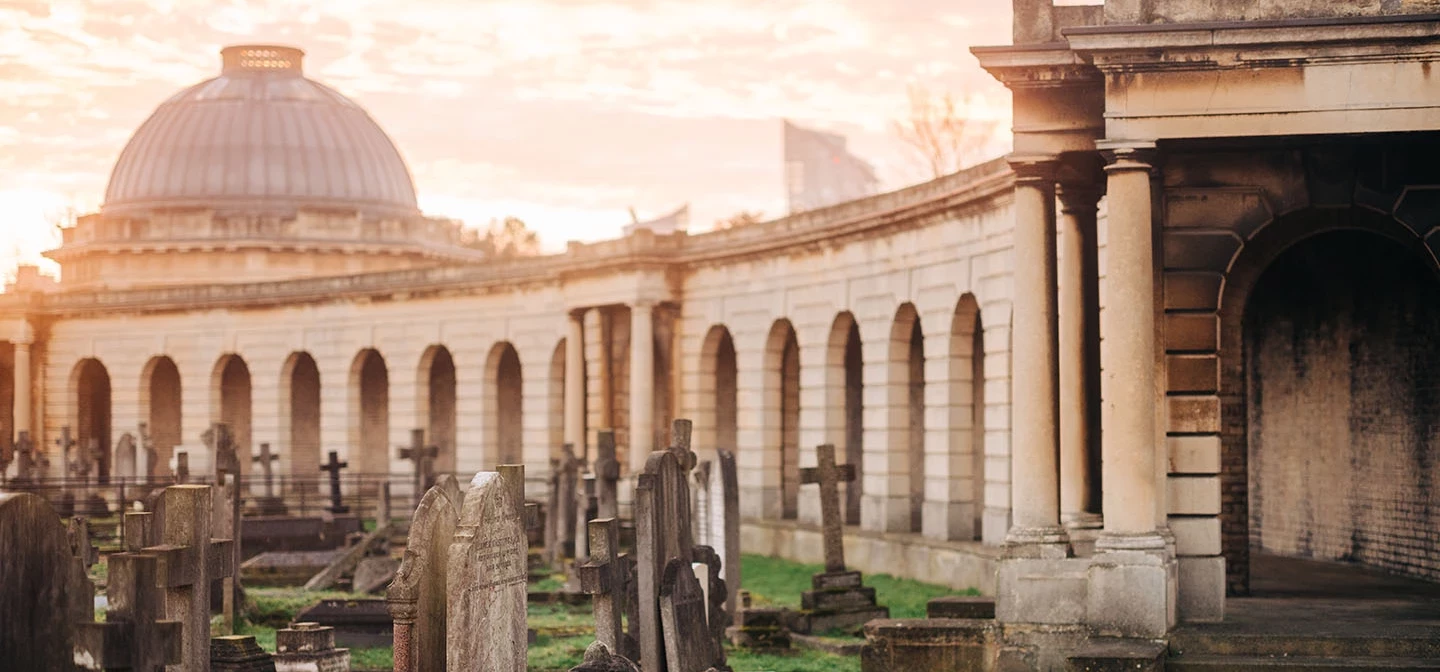
History of Brompton Cemetery
Key information
More than 205,000 people from 40 different nationalities lie buried in London’s atmospheric Brompton Cemetery.
London’s historic Brompton Cemetery – monuments, mausoleums and catacombs
In 1800, the population of London stood at around 1 million. But in just 50 years, it more than doubled – and soon the city was bursting with the dead, as well as the living. At this time, most people were buried in churchyards, but these were rapidly reaching capacity and this gruesome overcrowding began to threaten public health.
The solution was the creation of the ‘Magnificent Seven’: beautifully landscaped garden cemeteries that formed a ring around London. Grade I listed Brompton Cemetery is one of the oldest and best loved of these Victorian garden cemeteries.
Brompton Cemetery landscape and layout – a garden in stone
Brompton Cemetery was founded in 1840 by the architect, inventor and entrepreneur Stephen Geary. When the directors of the cemetery held an open competition to design its principal buildings, the board rejected Geary’s own proposals and chose instead those of Benjamin Baud.
Baud’s landscaping designs made a virtue of Brompton Cemetery’s rather uninspiring flat plot of land – creating an immense, tree-lined open air ‘cathedral’ with a 600 metre central ‘nave’. The planting layout was created by J.C. Loudon.
Strolling down Brompton’s Central Avenue
A wide, tree-lined Central Avenue became a favourite place for fashionable Victorian families to stroll, picnic and people-watch. If you had the money, commissioning a family mausoleum or monument on Central Avenue was the equivalent of acquiring a Park Lane apartment in the afterlife.
The Catacombs of Brompton Cemetery
Beneath these elegant avenues and pathways lies the subterranean world of the Brompton Cemetery Catacombs, entered by heavy cast-iron doors carved with snakes and inverted torches. The Friends of Brompton Cemetery run regular guided tours of the catacombs, where some chose to be buried in coffins stored on large shelves. Inside, you can still see some of the original Victorian funeral flowers that mourners placed beside their dearly departed.
Although there was room for thousands of burials, only 500 people chose to be interred in the Catacombs.
Who is buried in Brompton Cemetery?
Brompton Cemetery is the final resting place for over 205,000 people, from surgeons, suffragettes and opera singers to racing drivers, arctic explorers and entrepreneurs.
These are some of the famous graves to look out for:
- A simple Celtic Cross marks the grave of Emmeline Pankhurst, the courageous leader of the suffragette movement who fought for women’s right to vote
- The fastest man to row the River Thames, Robert Coombes is commemorated with an upturned rowing boat.
- The racing driver Percy Lambert, who broke the 100 miles per hour speed record, lies buried beneath a broken column, signifying a life cut short.
The end of the 1800s and the decline of Brompton Cemetery
By 1900, Brompton Cemetery had seen 155,000 interments, but this soon dwindled and the cemetery was closed to new burials in 1952. Today, Brompton is a working cemetery once again, and it’s possible to be buried in this beautiful, historic setting.
The cemetery is now a quiet, secluded haven, and a wonderful habitat for wildlife.